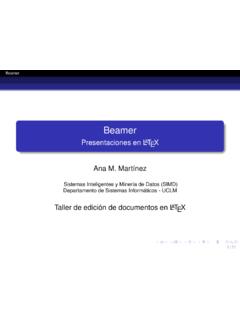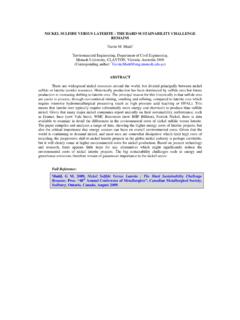Transcription of Semantics and Pragmatics Introduction
1 1/38. Semantics and Pragmatics [Chapter 19, Keith Allan]. Introduction Semantics is the study and representation of the meaning of every kind of constituent and expression (from morph to discourse) in human languages, and also of the meaning relationships among them. Twentieth century Semantics , especially in the period 1960-2000, has roots that stretch back to the Pre-Socratics of Greece in the sixth to fifth centuries BCE. Pragmatics deals with the context dependent assignment of meaning to language expressions used in acts of speaking and writing. Though Pragmatics is often said to have arisen from the work of Peirce (1931), Aristotle also wrote on certain aspects of Pragmatics (Allan 2004) and illocutionary types (acts performed through speaking; see below and chapter 20) were identified by the Stoics (second century BCE), Apollonius Dyscolus, St. Augustine, Peter Abelard, and Thomas Reid before being rediscovered by speech act theorists such as Austin (1962) and Searle (1969; 1975) (for discussion see Allan 2010).
2 Furthermore, at least since the time of Aristotle there have been commentaries on rhetoric and oratory. So, various aspects of Pragmatics have a long history. To chronicle the annual achievements in Semantics and Pragmatics from 1960 to 2000. would be almost unreadable and certainly unhelpful. Instead more or less chronological threads of development will be presented within thematic areas. These are divided into four major sections: Lexical Semantics ; The Semantics ~Syntax Interface; Logic and Linguistic Meaning; and Aspects of Pragmatics . Developments in any one topic area were often influenced by developments elsewhere, and the subdivisions within them are not discrete, as we shall see. The chapter concludes with a short essay on the importance of scripts (predictable personae and sequences of events) and conversational implicatures (probable inferences that arise from conventional expectations) which allow for the underspecification of meaning in language that renders natural languages much less explicit than most computer programming languages.
3 One problem that has been raised repeatedly over the course of the period in question and which underlies much of the discussion here is the scope of Semantics (and thus the definition of meaning). For some scholars Semantics studies entities such as words in isolation, and thus Semantics concerns only the type of decontextualized, abstract information that would be 2/38. given in a dictionary. However, for others, Semantics covers much more. This can be the type of information found in an encyclopedia a structured data-base containing exhaustive information on many (perhaps all) branches of Or, it can be the relation of the word to other words in the co-text (the surrounding text), or the relation to the context of the speech event in which the word is used, experiences, beliefs and prejudices about the context in which it is used. Lexical Semantics Here I discuss componential analysis, semantic fields, semantic primes, prototype Semantics , stereotype Semantics and lexicography.
4 The rise of componential analysis Until the mid-1960s twentieth century linguistic semanticists focused on lexical Semantics , in particular the componential analysis of lexemes and semantic relations among them (see also chapter 21 for a discussion of lexicology). A lexeme is an item listed in the dictionary (or lexicon ), a language expression whose meaning is not determinable from the meanings (if any) of its constituent forms and which, therefore, a language user must memorize as a combination of form and meaning. 2 Examples of lexemes are simple words like cat, walk, and, from, complex words with derivational affixes like education, reapply, compounds like loudspeaker, baby-sit, high school, phrasal verbs like look up, slow down, idioms like kick the bucket, and proverbs like a stitch in time saves nine. What is more controversial is whether clich s like bread and butter (but not butter and bread), ham and cheese, formulaic expressions (many happy returns, it's nice to meet you), expletives (uh, huh; damn), phonesthemes like the fl- onsets to flee, flicker, flare, etc.
5 Are lexemes. Serious proposals for incorporating these into dictionaries were discussed by several scholars (Weinreich 1969;. Makkai 1972; Jackendoff 1995; Allan 2001; Stubbs 2001; and most interestingly in Wray 2002). Componential analysis is typically based on the sense of a lexeme such as can be found in a dictionary, that is, decontextualized meaning, abstracted from innumerable occurrences (in texts) of the lexeme or combination of lexemes. In componential analysis, this sense is identified in terms of one or more semantic components. The principal means of accomplishing this has been through the structuralist method of contrastive distributional 1. The place of proper names and the problematic relationship between the dictionary and encyclopedia are examined by Allan (2001; 2006a); Hanks (1979). 2. The term lexeme' is used here because it is the word most used in the literature. Others have used listeme' for this meaning (Di Sciullo and Williams 1987; Allan 2001).
6 3/38. analysis. Lexemes that share semantic components are semantically related. There is no consistent one-to-one correlation between semantic components and either the morphs or the morphemes of any language. Being components of sense, semantic components reflect the characteristics of typical denotata. The denotatum, denotation', of a language expression is what it is normally used to refer to in some possible world. So, the denotata ( denotations'). of cat are any animals that the English word cat (and cats) can be used to refer to. There is a hierarchy of semantic components which corresponds to perceived hierarchies among denotata. For instance, FELINE is a semantic component of cat and entails the semantic component ANIMAL which is also, therefore, a component of cat. This suggests a thesaurus- like structure for semantic components. It follows that the set of semantic components for a language can be discovered by identifying all the relationships that can be conceived of among the denotata of lexemes.
7 In practice, this could be everything in all worlds, actual and non-actual, a procedure that has never been successfully achieved. In American linguistics up to 1960 (see chapter 16), Leonard Bloomfield (see especially 1933) the major figure of this period was sympathetic to the cultural context of language, but he came to exclude Semantics from the Bloomfieldian tradition in American linguistics on the grounds that Semantics is not directly observable in the way that phonemes, morphemes, and sentences are manifest in phones. So, from the 1940s until the 1960s, Semantics was regarded by many American linguists as metaphysical and unfit for the kind of scientific enquiry into observable language structures that they believed linguistics should undertake. The advance towards semantic analysis was therefore made within morphosyntax and by European linguists, using as a model Roman Jakobson's work on the general theory of case (1936).
8 Jakobson identified the conceptual features of each case in Russian using the methodology of Prague School phonology (see chapter 14, Part two, and chapter 22). Thus, according to Jakobson (1936) each Russian case is distinguished from other cases in terms of the presence or absence of just the four features [ directedness], [ status], [ scope] (the scope of involvement in the context of the utterance), and [ shaping] (identifying a container or bounded area). The idea of characterizing cases in terms of distinguishing components can be applied to the traditional analysis of the nominal suffixes in Latin so as to identify features from the categories of case (NOMINATIVE GENITIVE DATIVE ACCUSATIVE . 3. ABLATIVE) , gender (MASCULINE FEMININE NEUTER), number, and declension type. For instance ACCUSATIVE FEMININE SINGULAR FIRST_DECLENSION generates the suffix - am as in f minam woman ; ABLATIVE MASCULINE SINGULAR SECOND_DECLENSION.
9 3. is logical disjunction, or ; is logical conjunction, and . 4/38. generates the suffix as in puer by the boy . In Componential analysis of a Hebrew paradigm', Zellig Harris (1948) analyzed the verb paradigm using the categories of tense, person, and gender on a similar distributional basis to this; the result corresponds to Jakobson's analysis in terms of conceptual features. It is a small step from the componential analysis of closed morphosyntactic systems like case systems to the componential analysis of closed semantic fields like kinship systems. Anthropologists had for many years been comparing widely differing kinship systems in culturally distinct societies by interpreting them in terms of universal constituents (such as FEMALE_PARENT_OF, MALE_SIBLING_OF) that equate to semantic components. Two of the earliest articles in the componential analysis of meaning (Lounsbury 1956 and Goodenough 1956), appeared consecutively in the same issue of the journal Language and were both analyses of kin terms.
10 Without stepping far outside the Bloomfieldian tradition, these early writers on componential analysis were responsible for changing contemporary linguistic opinion by showing that semantic analysis could be carried out using approved methods of structural analysis, similar to those used, for example, to filter out the phonetic components of the Sanskrit stop phonemes. For instance, Floyd Lounsbury's paper begins with a comparison of Spanish and English kin terms: ti-o, hij-o, abuel-o, herman-o ( uncle', son', grandfather', brother') vs ti-a, hij-a, abuel-a, herman-a ( aunt', daughter', grandmother', sister'). He notes that English has no gender morphs corresponding to the Spanish suffixes -o and -a, but gender is nonetheless a significant component in the meaning of the English kin terms. Their covert gender must be compatible with the sex of the person denoted; consequently, it is anomalous to call one's uncle aunt, or one's sister brother.




